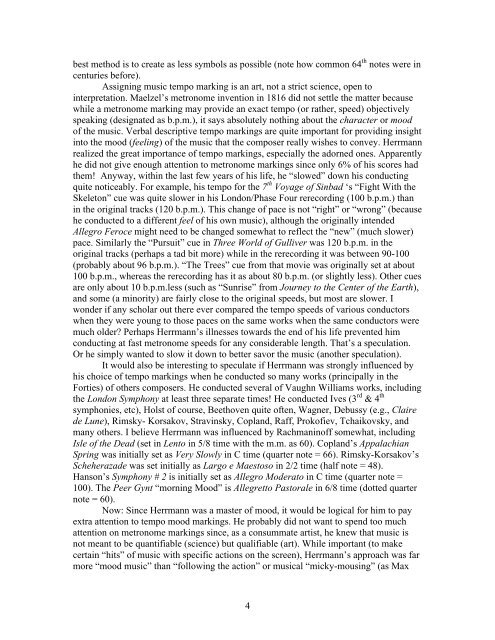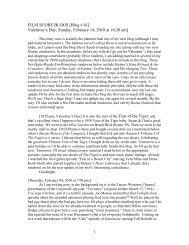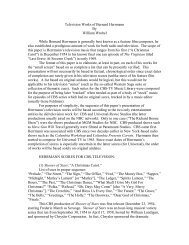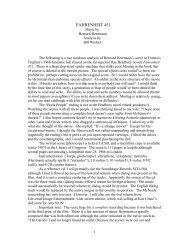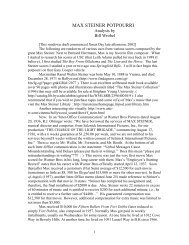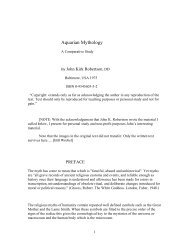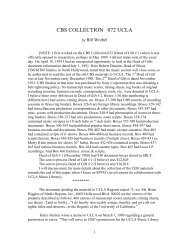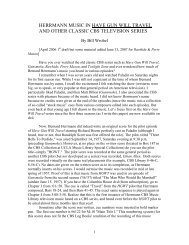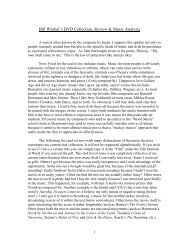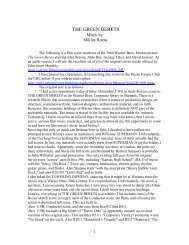TEMPO MARKINGS OF BERNARD HERRMANN SCORES ...
TEMPO MARKINGS OF BERNARD HERRMANN SCORES ...
TEMPO MARKINGS OF BERNARD HERRMANN SCORES ...
Create successful ePaper yourself
Turn your PDF publications into a flip-book with our unique Google optimized e-Paper software.
est method is to create as less symbols as possible (note how common 64 th notes were in<br />
centuries before).<br />
Assigning music tempo marking is an art, not a strict science, open to<br />
interpretation. Maelzel’s metronome invention in 1816 did not settle the matter because<br />
while a metronome marking may provide an exact tempo (or rather, speed) objectively<br />
speaking (designated as b.p.m.), it says absolutely nothing about the character or mood<br />
of the music. Verbal descriptive tempo markings are quite important for providing insight<br />
into the mood (feeling) of the music that the composer really wishes to convey. Herrmann<br />
realized the great importance of tempo markings, especially the adorned ones. Apparently<br />
he did not give enough attention to metronome markings since only 6% of his scores had<br />
them! Anyway, within the last few years of his life, he “slowed” down his conducting<br />
quite noticeably. For example, his tempo for the 7 th Voyage of Sinbad ‘s “Fight With the<br />
Skeleton” cue was quite slower in his London/Phase Four rerecording (100 b.p.m.) than<br />
in the original tracks (120 b.p.m.). This change of pace is not “right” or “wrong” (because<br />
he conducted to a different feel of his own music), although the originally intended<br />
Allegro Feroce might need to be changed somewhat to reflect the “new” (much slower)<br />
pace. Similarly the “Pursuit” cue in Three World of Gulliver was 120 b.p.m. in the<br />
original tracks (perhaps a tad bit more) while in the rerecording it was between 90-100<br />
(probably about 96 b.p.m.). “The Trees” cue from that movie was originally set at about<br />
100 b.p.m., whereas the rerecording has it as about 80 b.p.m. (or slightly less). Other cues<br />
are only about 10 b.p.m.less (such as “Sunrise” from Journey to the Center of the Earth),<br />
and some (a minority) are fairly close to the original speeds, but most are slower. I<br />
wonder if any scholar out there ever compared the tempo speeds of various conductors<br />
when they were young to those paces on the same works when the same conductors were<br />
much older? Perhaps Herrmann’s illnesses towards the end of his life prevented him<br />
conducting at fast metronome speeds for any considerable length. That’s a speculation.<br />
Or he simply wanted to slow it down to better savor the music (another speculation).<br />
It would also be interesting to speculate if Herrmann was strongly influenced by<br />
his choice of tempo markings when he conducted so many works (principally in the<br />
Forties) of others composers. He conducted several of Vaughn Williams works, including<br />
the London Symphony at least three separate times! He conducted Ives (3 rd & 4 th<br />
symphonies, etc), Holst of course, Beethoven quite often, Wagner, Debussy (e.g., Claire<br />
de Lune), Rimsky- Korsakov, Stravinsky, Copland, Raff, Prokofiev, Tchaikovsky, and<br />
many others. I believe Herrmann was influenced by Rachmaninoff somewhat, including<br />
Isle of the Dead (set in Lento in 5/8 time with the m.m. as 60). Copland’s Appalachian<br />
Spring was initially set as Very Slowly in C time (quarter note = 66). Rimsky-Korsakov’s<br />
Scheherazade was set initially as Largo e Maestoso in 2/2 time (half note = 48).<br />
Hanson’s Symphony # 2 is initially set as Allegro Moderato in C time (quarter note =<br />
100). The Peer Gynt “morning Mood” is Allegretto Pastorale in 6/8 time (dotted quarter<br />
note = 60).<br />
Now: Since Herrmann was a master of mood, it would be logical for him to pay<br />
extra attention to tempo mood markings. He probably did not want to spend too much<br />
attention on metronome markings since, as a consummate artist, he knew that music is<br />
not meant to be quantifiable (science) but qualifiable (art). While important (to make<br />
certain “hits” of music with specific actions on the screen), Herrmann’s approach was far<br />
more “mood music” than “following the action” or musical “micky-mousing” (as Max<br />
4


